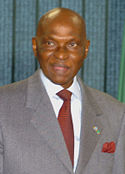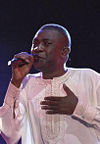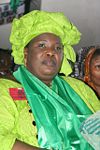Wolof people
| Wolof |
|---|
    |
| Notable Wolof: Akon, Abdoulaye Wade, Youssou N'Dour, Aminata Ndiaye |
| Total population |
|
3.6 million[1] |
| Regions with significant populations |
| Senegal: 3.2 million The Gambia: |
| Languages |
| Wolof, French (Senegal and Mauritania), English (The Gambia), Hassaniya (Mauritania) |
| Religion |
| Sunni Islam (%90), Animism (%6), Christianity (%2)[2] |
| Related ethnic groups |
| Lebou |


The Wolof are an ethnic group found in Senegal, The Gambia, and Mauritania.
In Senegal, the Wolof form an ethnic plurality with about 40% of the population self-identifying as Wolof. They are also the majority in the region stretching from Saint-Louis in the north, Kaolack in the south, and Dakar to the west. However, there are few Wolof who reside in Casamance.
In The Gambia, about 15% of the population are Wolof. Here, they are a minority, where the Mandinka are the majority with 40% of the population, yet Wolof language and culture have a disproportionate influence because of their prevalence in Banjul, The Gambia's capital, where 50% of the population are Wolof.
In Mauritania, about 7% of the population are Wolof. They live largely in the southern coastal region of the country.
Contents |
Orthography
In older French publications the spelling "Ouolof" is often used instead of "Wolof". In some English publications, predominantly those referring to Gambian Wolof, the spelling "Wollof" is used, because this spelling will induce native English speakers to pronounce the term correctly as a Wolof speaker. In publications of the 19th century and before the spelling "Volof" and "Olof" can also be found. Rarely used are also the spellings "Jolof", "Jollof" and "Dyolof". - The term "Wolof" itself may also refer to the Wolof language or to things originating from Wolof culture or tradition.
Historical state
The Wolof Empire was a medieval West African state that ruled parts of Senegal and The Gambia from approximately 1350 to 1890. While only ever consolidated into a single state structure for part of this time, the tradion of governance, caste, and culture of the Wolof dominate the history of north-central Senegal for much of the last 800 years. It's final demise at the hands of French colonial forces in the 1870s-1890s also marks the beginning of the formation of Senegal as a unified state.
Culture
Wolof people’s traditional culture and practices survive from the pre-colonial period, and while a dominant force in Senegalese culture, differ that of the other ethnic groups.
Language
"Wolof" is the name of the native language of the Wolof people (see Wolof language). Because 40% of Senegal's population are native speakers of Wolof, Wolof culture and language have an enormous influence, especially in urban areas. 94% of Senegalese, including non-Wolofs, can speak the language.
Religion
The vast majority of the Wolof people, like the population of Senegal, are Muslim, with minorities practicing Christianity and others adhering solely to pre-Islamic Animist traditions. The Senegalese Sufi Muslim brotherhoods, appearing in Wolof communities in the 19th century, grew tremendously in the 20th. Their leaders, or marabouts, exercise a huge cultural and political influence amongst most Muslim communities, most notably the leader of the Mouride brotherhood, Serigne Mouhamadou Lamine Bara Mbacke.
Wolof ceremonial traditions
Ceremonies such as weddings, funerals, and baptisms, while not unique, are have traditional elements distinctive to the Wolof. Many aspects of these traditional ceremonies have merged and been modified though the 20th century.
Weddings
Prior to traditional Wolof wedding ceremonies, the parents of the groom-to-be sends elders to the girl’s parents with kola nuts and money to ask for her hand in marriage. The girl’s parents consult their daughter to and either consent to or reject the proposal.[3]. If accepted, the parents of the bride to be distribute the kola nuts among the family and neighbours. This distribution is an informal way of announcing the impending wedding. In more traditional practices, the groom to be’s family paid the girl’s bride price in the form of money. This tradition, where surviving, has been modernized and dowry is paid in money, cars or even houses. After the completion of the groom’s obligations, the two families set a wedding day. Before the wedding day, the groom’s family gives a party is to welcome their daughter and to prepare her to live with her family in law. The imam and elders advise the groom with the presence of the some representatives of the bride’s parents.
Weddings traditionally take place at the groom's home. Parents receive guests with food and drink (but not alcohol), while guests bring gifts of money, rice, drinks, ships, sugar, or spices. After the ceremony people feast and dance with guests hiring a griot (praise-singer) and giving further gifts to the groom’s parents. The girl moves to the husband's (or his parent's) home or compound, bringing utensils for cooking which she buys by the money from the bride price.
Notable Wolof people
- Anna Kingsley (Anta Majijeen N´Dyaye)
- Akon[4]
- Youssou N'Dour
- Ousmane Sembène
- Abdoulaye Wade
Bibliography
- Cissé, Mamadou (2004). Dictionnaire Français-Wolof. Paris: L’Asiathèque. ISBN 2911053435.
- Cissé, Mamadou (1994). Contes wolof modernes. Paris: L’Harmattan. ISBN 2738430163.
- Malherbe, Michel; Sall, Cheikh (1989). Parlons Wolof – Langue et culture. Paris: L'Harmattan. ISBN 2738403832.
- Bichler, Gabriele Aïscha (2003). Bejo, Curay und Bin-bim? Die Sprache und Kultur der Wolof im Senegal (mit angeschlossenem Lehrbuch Wolof). Europäische Hochschulschriften. 90. Frankfurt am Main: Peter Lang Verlagsgruppe. ISBN 3631398158.
- Fal, Arame; Santos, Rosine; Doneux, Jean Léonce (1990). Dictionnaire wolof-français (suivi d'un index français-wolof). Paris: Karthala. ISBN 2865372332.
- Goetz, Rolf (1996). Senegal – Gambia: Praktischer Reiseführer an die Westküste Afrikas. Frankfurt am Main: Verlag Peter Meyer Reiseführer. ISBN 3922057098.
References
- ↑ ethnologue.com (2002 figures)
- ↑ Senegal:Religion, africaguide.com (1996-2008).
- ↑ People and culture of Senegal. (2007). Africaguide. Retrieved May 30, 2007 from http://africaguide.com/country/senegal/culture.htm
- ↑ Akon